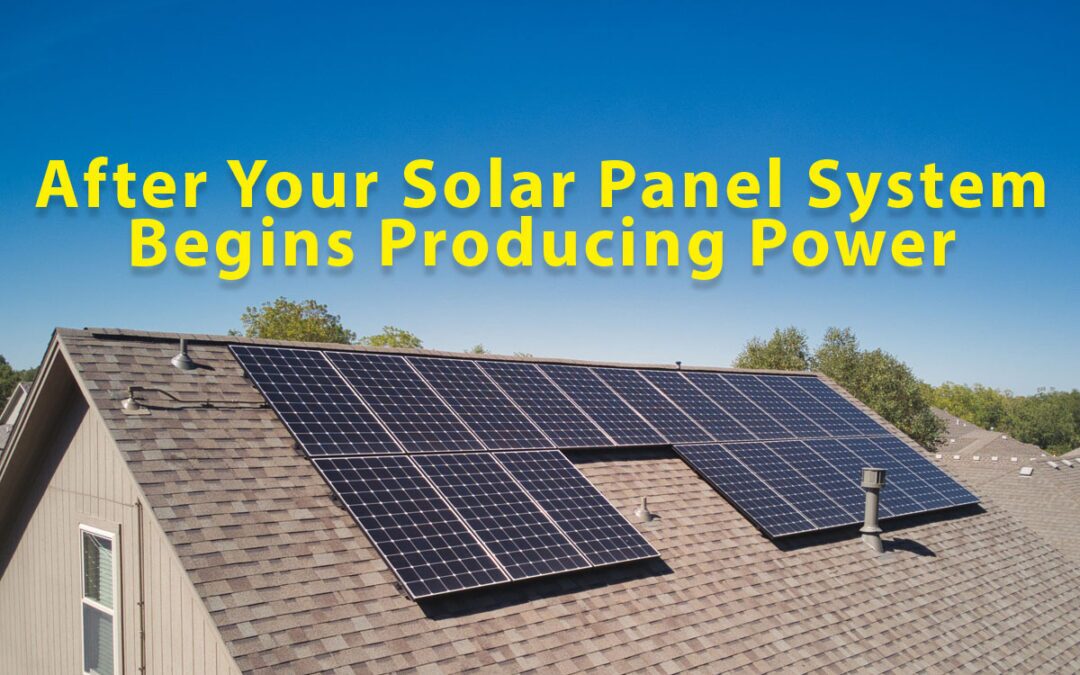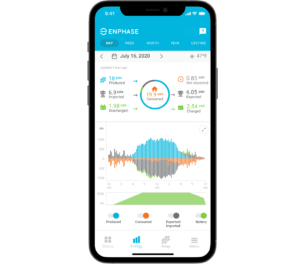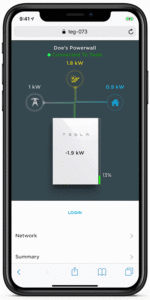Going solar means lower monthly electricity bills and consistent renewable energy generation. Once your utility turns on the solar installation for the first time, it’s important to have realistic expectations of what your solar system is capable of throughout the year. Here is what you can expect from your solar panel system after it becomes fully operational.
How will net metering work with my monthly electric bills?
Once your solar panel system is installed, your utility will replace your old electric meter with a bi-directional meter, or they may install an additional meter. This new meter will keep track of the power coming to your home from the utility as well as any excess power going out from your solar panels onto the grid.
Here’s an example of what an Evergy bill for a home looks like after solar is installed.
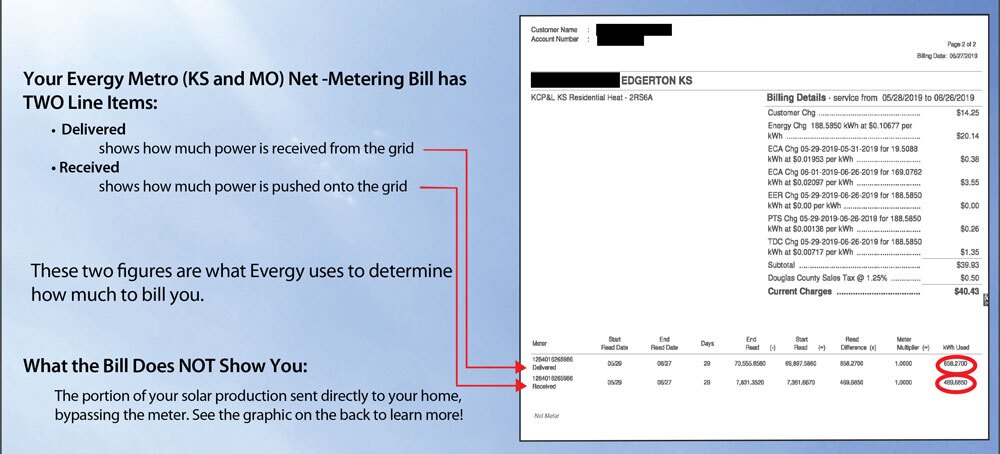
An example of an Evergy electric bill after solar is installed.
We also have examples of solar bills for Freestate Electric Coop customers here and Evergy customers located in Central Kansas here.
Your utility company won’t issue you a cash payment for the excess electricity that your solar panels feed back to the grid. Instead, you will receive a credit for every kilowatt-hour (kWh) you send back to the grid. That credit will show up on your electricity bill and offset some of the costs associated with the energy you receive from your utility. If you generate more energy than you use, you may still have to pay recurring utility fees and taxes.
What’s the difference between watts, kilowatts and kilowatt-hours?
Kilowatts (kW) and kilowatt-hours (kWh) measure electricity differently. To put it simply, a kW measures how much power an electric appliance consumes. 1000 watts (W) equals one kW. A kWh measures the energy an appliance uses in kilowatts per hour. For example, if you heat your food with a 1,000-watt stove for one hour, you consume 1 kWh of energy.
Here are a couple more examples of electricity usage:
- Lower watts: If you are using a 100-watt device, such as a deep freezer, you would have to keep it powered on for 10 hours before reaching 1 kWh.
- Higher watts: If you are running a 2,000-watt appliance, such as an air conditioner, you only need to power it for 30 minutes to reach 1 kWh.
Energy companies typically charge you based on the kWh your use.
How do I see how much electricity my solar installation is producing?
Every solar panel system that we install comes with web-based monitoring. You should be able to follow your system’s production through an app on your phone.
With most solar panel monitoring apps, you can quickly see if your electrical system is generating its own energy from the sun, drawing power from the electrical grid or sending excess energy produced back to your utility.
Is my solar panel system generating as much energy as I was promised?
Say you were sold a 4 kW solar installation (10 400 watt solar panels = 4,000 watts, or 4 kilowatts). That doesn’t necessarily mean that it will output 4 kW of electricity. Solar panels are categorized using STC ratings (Standard Test Conditions). Using laboratory conditions, scientists run solar panels through a series of tests that measure how much energy they produce. These tests don’t take into account weather conditions, potential shading from trees, the angle of your solar panels, how many hours a day your panels receive direct sun and what direction they face.
For this reason, your 4 kW solar panel system will rarely produce its full STC rating. Even when the array approaches that maximum output with perfect weather, inefficiencies in the wire material and the inverting process will still limit AC output. When we size your solar installation, our consultants take this potential difference in production into account.
Generally speaking, a factor of 1.5 can be used when calculating electricity production for solar panel installations in eastern Kansas and western Missouri. For example, a 4 kW facing south will usually generate around 6,000 kWh of electricity every year (4,000 W x 1.5 = 6,000 kWh). Weather, tilt, and geographic location will of course effect the actual production, but this basic calculation will give you a general idea of how much electricity your system should produce.
Will my solar panels keep my lights on if there is a power outage?
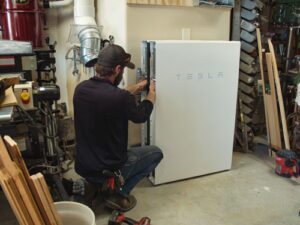 Not necessarily. The most common type of solar installation is grid-tied without battery-backup. In this scenario a power outage will shut your solar system down. Grid-tied solar systems, are specifically designed and listed to prevent power from flowing back onto the utility service lines when your home or business loses power from the grid. This system disconnect is created in order to protect utility workers attempting to reestablish power during an emergency. If you have a battery backup in place, that system will isolate your home’s electrical “microgrid” and will enable the solar panels to continue producing power to the battery, which will then provide power to your home.
Not necessarily. The most common type of solar installation is grid-tied without battery-backup. In this scenario a power outage will shut your solar system down. Grid-tied solar systems, are specifically designed and listed to prevent power from flowing back onto the utility service lines when your home or business loses power from the grid. This system disconnect is created in order to protect utility workers attempting to reestablish power during an emergency. If you have a battery backup in place, that system will isolate your home’s electrical “microgrid” and will enable the solar panels to continue producing power to the battery, which will then provide power to your home.
When the power goes out, your solar energy system needs a specific type of inverter to allow certain circuits in your building to remain functional while the sun shines. When the sun goes down, you’ll also need a battery type energy storage system like a Tesla Powerwall or an Enphase IQ to continue powering your most important appliances and devices.
How do I monitor or alter the settings of my solar battery?
Most solar batteries have an app that will allow you to interface with the unit. For instance, the Tesla Powerwall app allows you to manage your energy system from anywhere with a comprehensive view of your home. The app can help you monitor day-to-day operations and control the flow of energy in your home.
Your solar installer can help you set up your battery to achieve your energy goals. Different Powerwall settings include Backup Reserve, Self-Powered, Time-Based Control and Advanced Settings. These different modes can help your battery keep a set amount of energy available in case of emergency, reserve energy to use for when peak demand charges are highest and choose how much electricity you want to send back to the grid.
Who do I call if there is a problem with my solar installation?
When your solar panel installation doesn’t perform at its best, it’s time to call the Good Energy Solutions Solar Service department. Our team of solar technicians can diagnose and repair almost any problem.
When you have Good Energy Solutions maintain or fix your panel installation you can expect:
- Professional Solar Service
- Complete Troubleshooting
- Repairs and Diagnostics Performed by a Qualified Solar Technicians
Our team of dedicated technicians’ primary focus is to help solar installation owners get the most out of their system. That means maximizing your system’s power production, keeping monitoring apps up to date, and making sure all of your solar equipment is operating safely.
If you need help with your solar panel system, give us a call at (785) 371-1198 or leave us a message on our website at https://goodenergysolutions.com/contact-us/.

